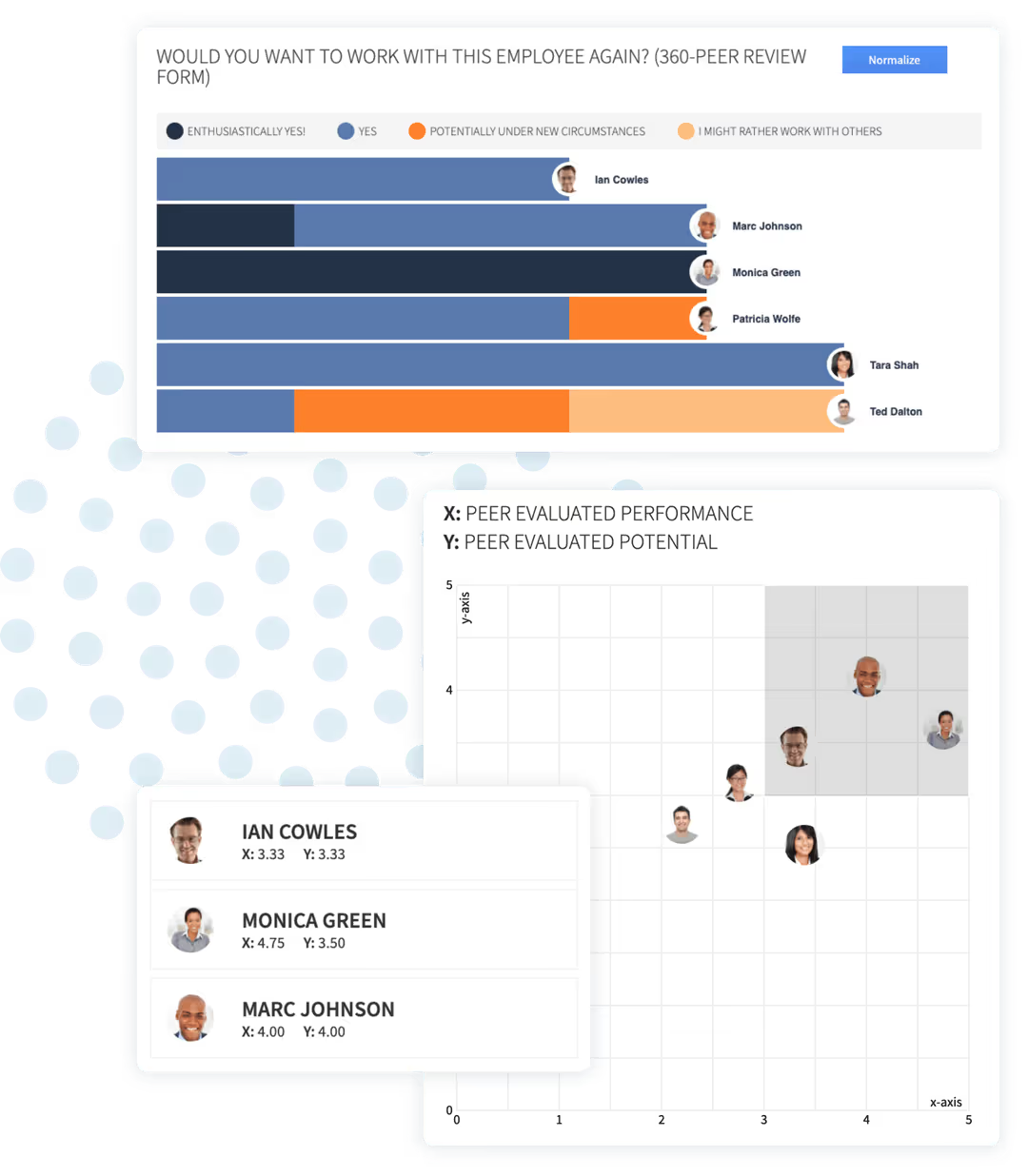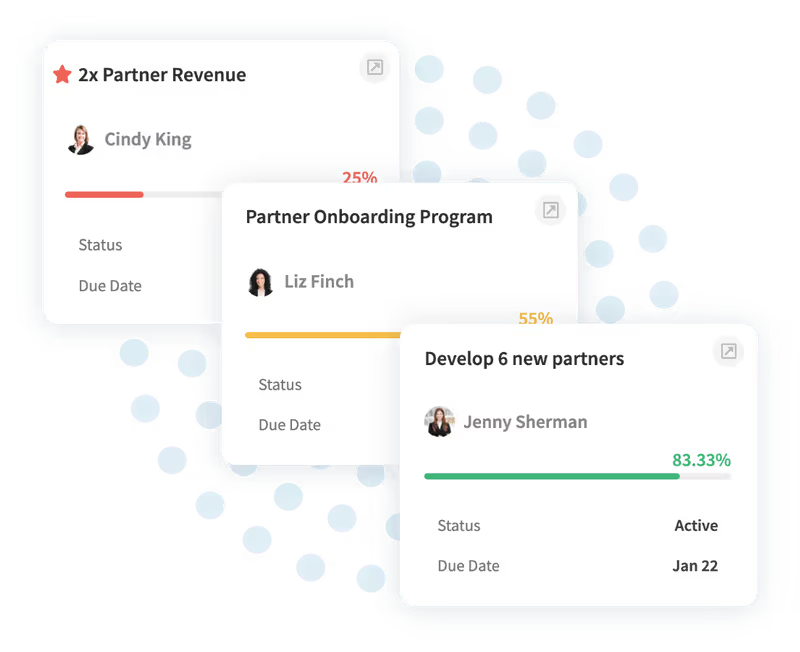Four Tips on How to Measure Employee Performance
How can you tell whether your employees are working harder or working smarter? Employees should work on the tasks that impact the bottom line. How do you measure employee performances it relates to company-wide objectives?
This article examines how to measure, what to measure, and how PerformYard’s performance management software can help.
What are four ways to measure employee performance?
You can measure employee performance in four primary ways. First, you can use both qualitative measurements and quantitative measurements. You can also track their professional development and contribution to company goals.
Qualitative Measurement
How to Measure
Qualitative measurement consists of input received from others. That includes peers, supervisors/managers, customers, and clients. These inputs provide insights into the experiences of those who have interacted and worked with the employee. This input can come in the form of:
- 1:1s – These are conversations between supervisors and employees. Supervisors share feedback that is positive and/or constructive.
- 360 reviews – This is input from those other than an employee’s direct supervisor or manager. It can come from peers, team members, or other managers.
- Continuous feedback – PerformYard allows you to provide real-time feedback and track employee performance.
What types of things can you measure through qualitative inputs? You’ll be measuring things related to employees’ soft skills.
What to Measure
Employees should have the ability to work with and through others. To do this, the employee must have a range of soft skills. These skills affect collaboration and relationships with coworkers, customers, and vendors. For instance
- Culture fit. To what extent do an employee’s actions and behaviors support the desired culture? Let’s say the culture values quality. How do employees’ efforts show a concern with quality? Are they efficient and effective?
- Collaboration. Communication skills are critical for any position. They’re even critical for individual contributors who have limited interactions with others. All employees get work done by working with others.
- Attitude. Attitude can relate to a willingness to work with others or a willingness to share expertise with others. It can also relate to a willingness to help a colleague who is struggling.
Different organizations will value different types of qualitative attributes.
Qualitative insights also can help identify quantitative employee performance measurement examples.
Quantitative Performance Measurement
Quantitative performance management offers more unbiased insights than qualitative feedback. Quantitative measurements might include such things as sales, production, and error rates.
How to Measure
The first step in quantitative performance measurement is establishing performance goals. What do managers expect of the employee? You can provide employees with the opportunity to define their own goals in consultation with their managers. Employees will feel a new level of ownership. When employees feel ownership, they’re more committed to their work. They will also be more likely to achieve goals because they set the goals themselves.
Once you establish goals, you can track them with PerformYard. The platform is a 24/7/365 resource for employees, managers, and HR. It allows you to track goals on a quarterly, monthly, or even more frequent basis. For instance, you may measure sales goals monthly but measure safety goals quarterly.

What to Measure
Quantitative measures of success will be different for every employee. The measurement will depend on the position they hold and their past performance.
Here are a few examples.
A salesperson might the following quantitative measures:
- Calls made
- Leads generated
- Total sales revenue
An employee whose attendance has been poor might have the following quantitative measures:
- Days showing up on time
- Hours worked
Professional Development Performance Measurement
Modern employees want opportunities for professional development. Your workforce will appreciate opportunities to continue to learn and grow. One of the best ways to increase engagement is to establish professional goals. You can track progress towards professional development goals within your performance management platform. Employees who grow at your organization will end up being more loyal to the company.
How to Measure
You can define training goals at the beginning of the year and incorporate them into annual goals. Training goals relate to specific goals employees will be working on during the year. They may also relate to individual career aspirations for the employee’s future. PerformYard allows you to categorize goals into different “buckets.” You can move goals into buckets such as professional development, sales, safety, and more.
PerformYard also allows you to measure progress on training goals. You can check in with employees during 1:1s or conduct scheduled meetings to discuss progress. PerformYard’s data will tell you if the employee needs support to achieve professional development goals.
What to Measure
You can measure professional goals by tracking the number of training sessions completed. Companies can also track how many new skills the employee acquired. You can also outcome measures such as scores on tests or the success of projects that use new skills.
Contribution to Company Goals
HR professionals use performance management to align goals. Aligning goals means tying the company’s goals to the goals of employees at every level of the organization.
How to Measure
PerformYard makes it easy to track employee contributions through cascading goals. Cascading goals show how employees’ performance drives important company outcomes.

Here's an example of cascading goals: Customer call center staff contribute to customer satisfaction.
You can measure how employees handle calls and the number of calls they answer each day. Those are the employee’s bottom-line metrics, but they’re tied to the company’s customer satisfaction metrics.
What to Measure
Some examples of company goals include:
- Company revenue numbers
- Company revenue growth numbers
- Profit vs spending
Employee performance goal contributions might include:
- Individual revenue growth
- Individual profit contributions
- Individual spending levels
Cascading goals align everyone based on organizational goals. This approach breaks up big-picture strategies into clear tasks and deliverables. It’s easy to communicate and track these goals with a software platform like PerformYard.
Company leaders can use the platform to see how goals align throughout the organization. The leadership team will be able to see how individual employees contribute to desired outcomes. Leadership can also see when employees need to move to new projects that have more of an impact on company goals.
How to measure employee performance with PerformYard
An online performance management system takes the hassle out of formal performance reviews. PerformYard fuels ongoing feedback and review throughout the year. The platform offers all-the-time access to performance management information. This access has become vital as remote or hybrid offices become more popular.
PerformYard removes the administrative burdens of traditional review processes. It also helps with automation and documentation. The platform ensures employees receive positive and constructive feedback throughout the year.

